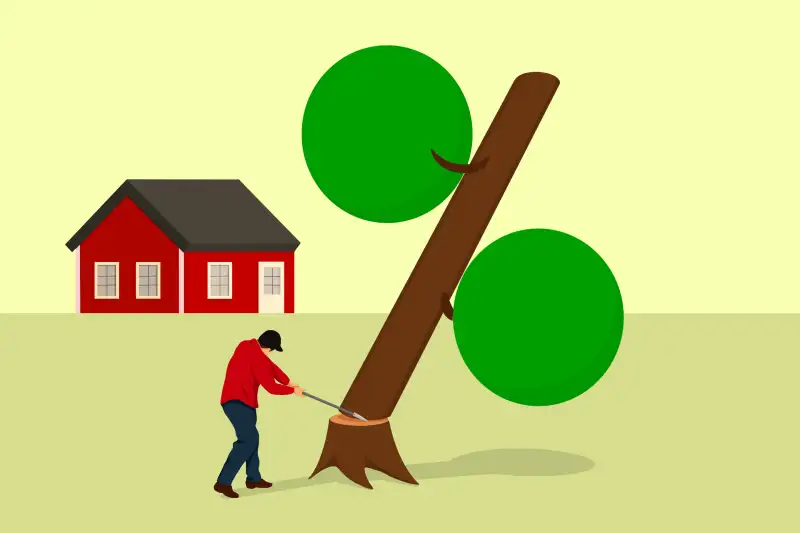6 Hacks to Get Around Sky-High Mortgage Rates

If you find yourself longing for the days of historically low interest rates, you’re not alone.
This year, the average rate on 30-year mortgages has more than doubled, climbing from around 3% to around 6.6%, according to Freddie Mac. As a result, average monthly payments have soared, jumping 50% in as little time.
Fortunately, mortgage rates — and payments — aren’t set in stone. In fact, there are several strategies that can reduce your rate and make buying a home more affordable, even in today’s challenging market.
Are you looking to become a homeowner despite rising interest rates? Try one of these lesser-known mortgage rate hacks for help.
1. Ask the seller (or builder) for help
It sounds counterintuitive, but sellers often pitch in to reduce a buyer’s interest rate — at least in high-rate markets like today.
“Rate buydowns that are paid for by sellers and builders are becoming fairly common to help drive home sales,” says Amit Patel, senior product manager for consumer lending at BMO Financial Group.
Here’s how those buydowns work: The seller agrees to what’s called a “concession,” essentially contributing a portion of their sale proceeds to the transaction. Those funds are paid to the lender in exchange for a lower mortgage rate.
These reductions can be either permanent, giving the buyer a lower rate and payment for the entire loan term, or temporary, resulting in lower costs for the first few years. A 2/1 buydown, for example, would offer a 2% lower rate on year one, a 1% lower rate on year two and, by year three, it would revert to the originally quoted rate and payment.
Just be careful with temporary buydowns if you choose this route. Mortgage lenders will require you to qualify for the loan at the final interest rate — not the reduced one, so make sure you’re able to afford the higher payments.
2. Buy points
You can also purchase a lower mortgage rate yourself. This is known as “buying points.”
“At any given time, there are multiple interest rates you can choose from,” says Ashwin Dayal, general manager of mortgage at real estate platform Orchard. “If you wish to get the lower rates, you can pay the lender a fee known as discount points. This rate would be lower for the life of the loan.”
While this requires some cash upfront (up to 1% of your loan amount for a 0.125 to 0.50 percentage point drop in rate), it can reduce your payments quite a bit.
Buying a median-priced home ($454,900) at a 7% rate with a 6% down payment (the average for first-time buyers) would come with a $2,844 monthly payment. If you could buy down your rate to 6%, though, you’d shave more than $300 off that amount.
If you’re thinking about buying points, make sure you plan to stay in your home long enough to reap the benefit. You can gauge this by calculating your breakeven point — or the month in which the buydown has saved you more than it cost. If buying points saves you $300 per month and costs you $9,000 upfront, then your breakeven point would be 30 months (9,000 divided by 300). If you don’t plan to stay in the home that long, it’s probably not worth it.
3. Consider different lenders — and negotiate with them
Every mortgage lender has its own overhead costs, staffing limitations, margins and appetite for risk, so the rate you’re offered by one company? It probably won’t be the same as what another quotes you. That means considering multiple lenders is critical to getting the lowest rate.
“The most important thing a borrower can do to obtain a lower mortgage rate is to do their homework — and shop around,” says Al Murad, executive vice president at AmeriSave Mortgage. “Rates can vary by several percentage points from lender to lender.”
When choosing which lenders to get quotes from, focus on variety — maybe an online lender, a bank and a credit union. Since credit unions are nonprofit (and typically don’t sell their loans to investors), they can often offer more competitive terms.
Using your own bank or moving money to a new bank may also help. These are often called “relationship” or “loyalty” perks and typically only apply if you have a significant amount of money in checking, savings or investment accounts somewhere. Chase, for example, offers a 0.125% rate reduction if you have $500,000 to $999,999 in deposits and investments or a 0.25% reduction for $1 million or more.
“We’ve seen a borrower’s bank offer amazing terms to individuals that have significant assets under management to retain their business,” says Jim Roberts, a mortgage broker at True North Mortgage Company.
Once you have some quotes in hand, compare your options and negotiate. Lenders may try to match or even beat other companies to win your loan.
“Each lender will send a loan estimate, which is a standard form and very easy to compare side by side,” says Brad Baker, vice president of underwriting and capital markets at Equity Now. “At this point, you can see who is offering the best pricing and determine if you want to negotiate, pitting the lenders against each other to compete for your business.”
4. Take over the seller’s old mortgage
Low mortgage rates were pretty common up until a few months ago, and according to a Redfin analysis, 85% of all homeowners with a mortgage have rates under 5%. If that sounds tempting, assuming your seller’s mortgage might be something to consider.
Assuming a mortgage essentially means taking it over. You’ll buy the house, but instead of applying for a whole new mortgage, you instead pick up where the old owner left off, paying the existing mortgage according to the terms and rate already in place.
To do this, you’ll need to come with plenty of cash. In order for the seller to get paid, you’ll need to have enough to cover their total home equity — or the home’s price minus their mortgage balance. So, for example, if the home’s priced at $300,000 and they still owe $230,000 on their mortgage, you’d have to bring $70,000 to the table (think of it like a down payment of sorts, only it goes straight to the seller — not the lender).
Loan assumptions aren’t allowed on all mortgage types. Government-backed loans like VA, USDA and FHA mortgages do allow them. Conventional loans, which make up about 65% of existing mortgages, do not.
“If you're a homebuyer shopping right now, you'll need to ask your lender for help finding out whether the seller of any home you're interested in has an FHA, VA or USDA loan,” says Jeff Taylor, co-founder and managing director at mortgage tech platform Mphasis Digital Risk. “If the seller's loan is assumable, you'll need to see if the rate and loan amount match your desired budget and down payment.”
If it does, you’ll work with the existing loan servicer to take over the loan. They’ll verify that you meet the requirements of the loan program (like being a military member or veteran for a VA loan) and that you have the financial qualifications to cover the payments.
If you can clear all those hurdles, be patient. “It can be a timely process, taking up to 90 days to complete,” says Dan Hanson, executive director at loanDepot.
5. Make a larger down payment
Your loan-to-value ratio — or how much you borrow compared to the home’s value — can play a big role in the rate you get. With a small down payment, your LTV is high, and the lender has more money on the line (i.e., more risk). Make a bigger one, and your LTV goes down, reducing the lender’s risk and the rate you’ll likely get.
“Generally speaking, a larger down payment equates to a lower interest rate,” Murad says. “This is because lenders assume a lower level of risk when a homeowner has a greater ownership stake in the property.”
Putting down a big down payment can be challenging in today’s market, especially with inflation and rising home prices, but there are creative ways to do it. You can sell off stocks, crypto or your aged car, or you can look into a down payment assistance program. These are often offered through local housing agencies and, in many cases, won’t need to be repaid.
If you’re not sure how much down you’d need to make a difference, talk to your lender. Typically, 20% is best if you want to avoid private mortgage insurance, which adds an extra fee to your monthly payment.
“A good loan officer can provide rate quotes based on various down payments,” Murad says. “Then you can determine which option works best for your specific financial situation.”
6. Consider an adjustable-rate mortgage, government-backed loan or shorter term
Finally, think outside the box when it comes to mortgage options. The 30-year mortgage loan might be the most popular option, but it’s usually not the most affordable in the long run.
If you think you’ll be in the home for just a few years (think three to 10 years, max), then an adjustable-rate mortgage can be a smart option. These offer much lower rates initially, but your rate can increase later on.
“You can, in a lot of cases, get a 5-year or 7-year ARM about 1% lower in rate than a fixed rate,” says Chuck Meier, vice president and mortgage sales director at SunriseBanks.com.
Just make sure you’re prepared to move or refinance before your rate can increase. (Otherwise, be prepared for a higher payment.)
You can also look at government-backed loan programs, like FHA and VA loans. Those typically have lower rates than conventional mortgages. Currently the difference is about 0.35 and 0.30 percentage points, respectively. It might sound small, but on a median-priced home, it comes out to about $100 in savings per month.
Shorter-term loans — like 10- and 15-year ones, for example — also have lower rates and save you on interest in the long run. However, the monthly payments are much higher because the loan balance is spread over fewer months. This might not do much for affordability, at least if monthly cash flow is your priority.
“Talk to your loan officer and figure out the best way to go,” says Jeremy Drobeck, senior loan origination at Amerifirst Home Mortgage. “Sometimes proper placement into the right loan program makes all the difference.”
More from Money:
Homebuyers and Sellers Alike Are Loving This Popular Trick to Lower Mortgage Rates

